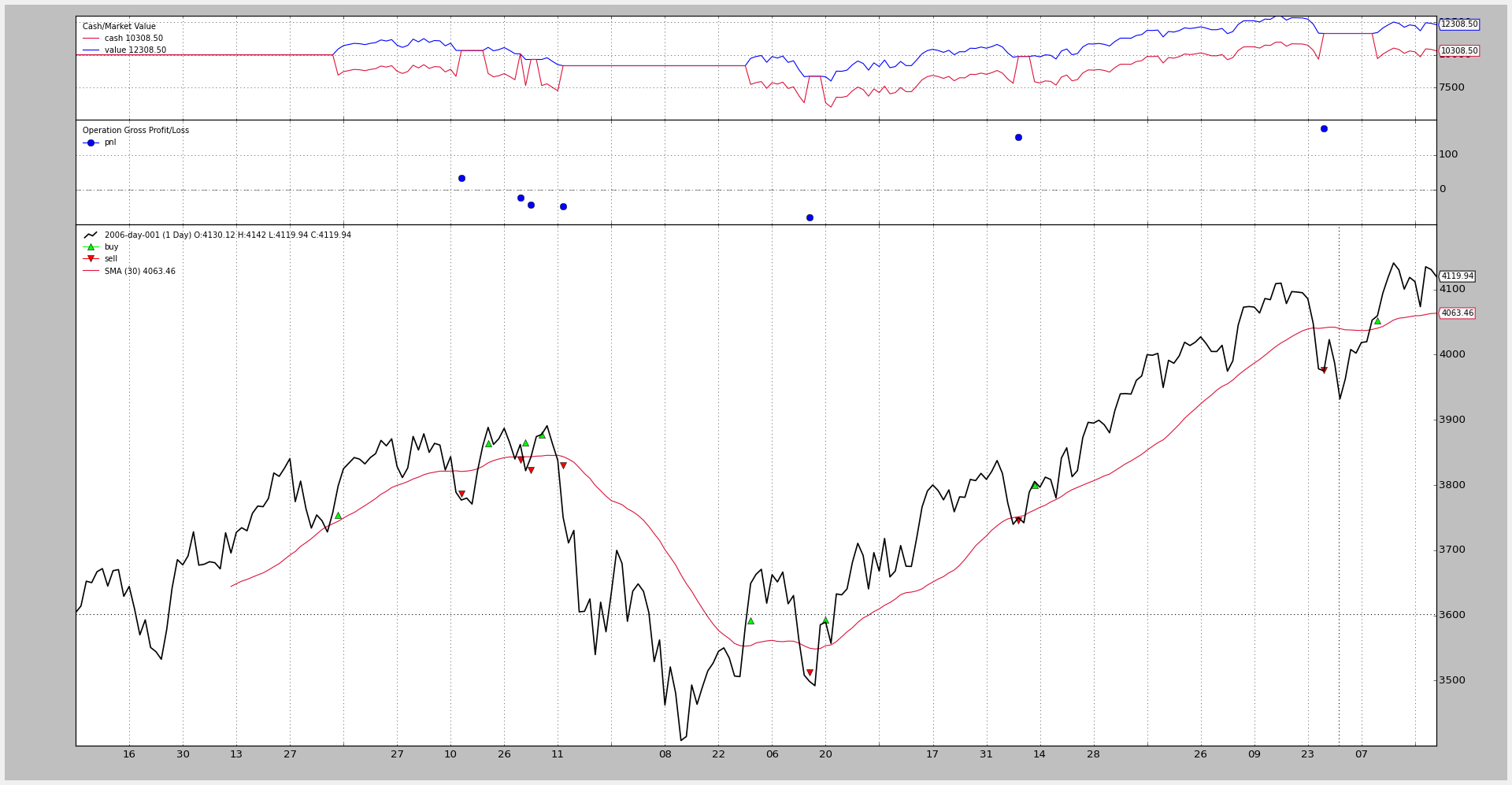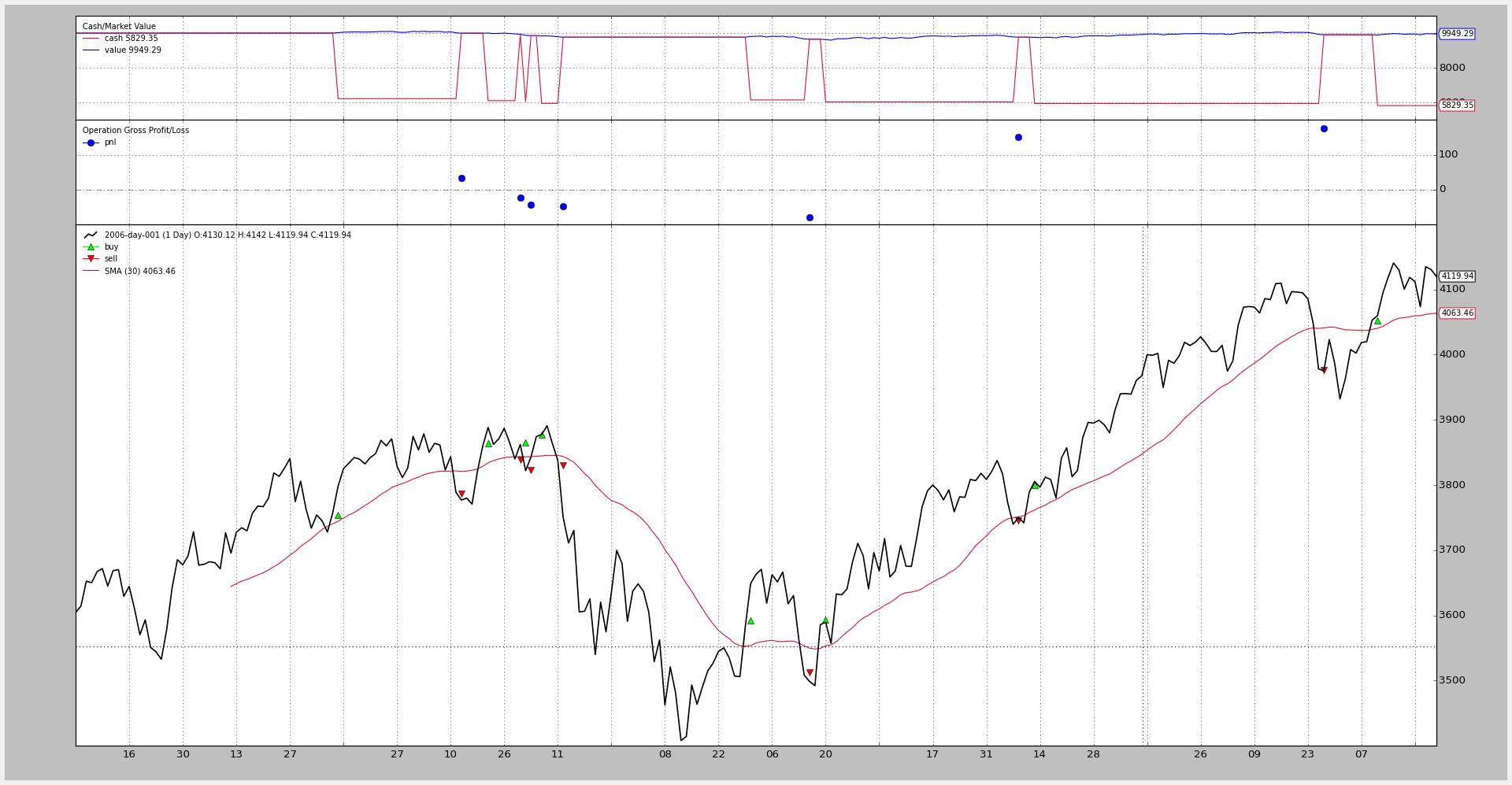Commissions: Stocks vs Futures
backtrader has been born out of necessity. My own … to have the feeling I control my own backtesting platform and can experiment new ideas. But in doing so and fully open sourcing it from the very beginning it was clear it has to have a way to fulfill the needs and wishes of others.
Being a traders future I could have chosen to code point based calculations and fixed price per round commissions, but it would have been a mistake.
Note
Jul 31, 2015
Follow up post with newly added operations/trades notifications, fixing the plotting of trades P&L figures and avoiding manual calculation like in the example below
Improving Commissions: Stocks vs Futures
Instead, backtrader offers the possibility to play with regular % size/price
based schemes and fixed price/point schemes. The choice is yours.
Agnosticity
Before going forward let’s remember that backtrader tries to remain agnostic
as to what the data represents. Different commission schemes can be applied to
the same data set.
Let’s see how it can be done.
Using the broker shortcuts
This keeps the end user away from CommissionInfo objects because a
commission scheme can be created/set with a single function call. Within the
regular cerebro creation/set-up process, just add a call to setcomission
over the broker member variable. The following call sets a usual commission
scheme for Eurostoxx50 futures when working with InteractiveBrokers:
cerebro.broker.setcommission(commission=2.0, margin=2000.0, mult=10.0)
Since most users will usually just test a single instrument, that’s all that’s
down to it. If you have given a name to your data feed, because several
instruments are being considered simultaneously on a chart, this call can be
slightly extended to look as follows:
cerebro.broker.setcommission(commission=2.0, margin=2000.0, mult=10.0,
name='Eurostoxxx50')
In this case this on-the-fly commission scheme will only applied to instruments
whose name matches Eurostoxx50.
The meaning of the setcommission parameters
-
commission(default: 0.0)Monetary units in absolute or percentage terms each action costs.
In the above example it is 2.0 euros per contract for a
buyand again 2.0 euros per contract for asell.The important issue here is when to use absolute or percentage values.
-
If
marginevaluates toFalse(it is False, 0 or None for example) then it will be considered thatcommissionexpresses a percentage of thepricetimessizeoperatin value -
If
marginis something else, it is considered the operations are happenning on afutureslike intstrument andcommissionis a fixed price persizecontracts
-
-
margin(default: None)Margin money needed when operating with
futureslike instruments. As expressed above-
If a no
marginis set, thecommissionwill be understood to be indicated in percentage and applied toprice \* sizecomponents of abuyorselloperation -
If a
marginis set, thecommissionwill be understood to be a fixed value which is multiplied by thesizecomponent ofbuyorselloperation
-
-
mult(default: 1.0)For
futurelike instruments this determines the multiplicator to apply to profit and loss calculations.This is what makes futures attractive and risky at the same time.
-
name(default: None)Limit the application of the commission scheme to instruments matching
nameThis can be set during the creation of a data feed.
If left unset, the scheme will apply to any data present in the system.
Two examples now: stocks vs futures
The futures example from above:
cerebro.broker.setcommission(commission=2.0, margin=2000.0, mult=10.0)
A example for stocks:
cerebro.broker.setcommission(commission=0.005) # 0.5% of the operation value
Creating permanent Commission schemes
A more permanent commission scheme can be created by working directly with
CommissionInfo classes. The user could choose to have this definition
somewhere:
from bt import CommissionInfo
commEurostoxx50 = CommissionInfo(commission=2.0, margin=2000.0, mult=10.0)
To later apply it in another Python module with addcommissioninfo:
from mycomm import commEurostoxx50
...
cerebro.broker.addcomissioninfo(commEuroStoxx50, name='Eurostoxxx50')
CommissionInfo is an object which uses a params declaration just like
other objects in the backtrader environment. As such the above can be also
expressed as:
from bt import CommissionInfo
class CommEurostoxx50(CommissionInfo):
params = dict(commission=2.0, margin=2000.0, mult=10.0)
And later:
from mycomm import CommEurostoxx50
...
cerebro.broker.addcomissioninfoCommEuroStoxx50(), name='Eurostoxxx50')
Now a “real” comparison with a SMA Crossover
Using a SimpleMovingAverage crossover as the entry/exit signal the same data set
is going to be tested with a futures like commission scheme and then with a
stocks like one.
Note
Futures positions could also not only be given the enter/exit behavior but a reversal behavior on each occassion. But this example is about comparing the commission schemes.
The code (see at the bottom for the full strategy) is the same and the scheme can be chosen before the strategy is defined.
futures_like = True
if futures_like:
commission, margin, mult = 2.0, 2000.0, 10.0
else:
commission, margin, mult = 0.005, None, 1
Just set futures_like to false to run with the stocks like scheme.
Some logging code has been added to evaluate the impact of the differrent commission schemes. Let’s concentrate on just the 2 first operations.
For futures:
2006-03-09, BUY CREATE, 3757.59
2006-03-10, BUY EXECUTED, Price: 3754.13, Cost: 2000.00, Comm 2.00
2006-04-11, SELL CREATE, 3788.81
2006-04-12, SELL EXECUTED, Price: 3786.93, Cost: 2000.00, Comm 2.00
2006-04-12, OPERATION PROFIT, GROSS 328.00, NET 324.00
2006-04-20, BUY CREATE, 3860.00
2006-04-21, BUY EXECUTED, Price: 3863.57, Cost: 2000.00, Comm 2.00
2006-04-28, SELL CREATE, 3839.90
2006-05-02, SELL EXECUTED, Price: 3839.24, Cost: 2000.00, Comm 2.00
2006-05-02, OPERATION PROFIT, GROSS -243.30, NET -247.30
For stocks:
2006-03-09, BUY CREATE, 3757.59
2006-03-10, BUY EXECUTED, Price: 3754.13, Cost: 3754.13, Comm 18.77
2006-04-11, SELL CREATE, 3788.81
2006-04-12, SELL EXECUTED, Price: 3786.93, Cost: 3786.93, Comm 18.93
2006-04-12, OPERATION PROFIT, GROSS 32.80, NET -4.91
2006-04-20, BUY CREATE, 3860.00
2006-04-21, BUY EXECUTED, Price: 3863.57, Cost: 3863.57, Comm 19.32
2006-04-28, SELL CREATE, 3839.90
2006-05-02, SELL EXECUTED, Price: 3839.24, Cost: 3839.24, Comm 19.20
2006-05-02, OPERATION PROFIT, GROSS -24.33, NET -62.84
The 1st operation has the following prices:
-
BUY (Execution) -> 3754.13 / SELL (Execution) -> 3786.93
-
Futures Profit & Loss (with comission): 324.0
-
Stocks Profit & Loss (with commission): -4.91
Hey!! Commission has fully eaten up any profit on the
stocksoperation but has only meant a small dent to thefuturesone. -
The 2nd operation:
-
BUY (Execution) -> 3863.57 / SELL (Execution) -> 3389.24
-
Futures Profit & Loss (with commission): -247.30
-
Stocks Profit & Loss (with commission): -62.84
The bite has been sensibly larger for this negative operation with
futures -
But:
-
Futures accumulated net profit & loss: 324.00 + (-247.30) = 76.70
-
Stocks accumulated net profit & loss: (-4.91) + (-62.84) = -67.75
The accumulated effect can be seen on the charts below, where it can also be seen that at the end of the full year, futures have produced a larger profit, but have also suffered a larger drawdown (were deeper underwater)
But the important thing: whether futures or stocks … it can be
backtested.
Commissions for futures
Commissions for stocks
The code
from __future__ import (absolute_import, division, print_function,
unicode_literals)
import backtrader as bt
import backtrader.feeds as btfeeds
import backtrader.indicators as btind
futures_like = True
if futures_like:
commission, margin, mult = 2.0, 2000.0, 10.0
else:
commission, margin, mult = 0.005, None, 1
class SMACrossOver(bt.Strategy):
def log(self, txt, dt=None):
''' Logging function fot this strategy'''
dt = dt or self.datas[0].datetime.date(0)
print('%s, %s' % (dt.isoformat(), txt))
def notify(self, order):
if order.status in [order.Submitted, order.Accepted]:
# Buy/Sell order submitted/accepted to/by broker - Nothing to do
return
# Check if an order has been completed
# Attention: broker could reject order if not enougth cash
if order.status in [order.Completed, order.Canceled, order.Margin]:
if order.isbuy():
self.log(
'BUY EXECUTED, Price: %.2f, Cost: %.2f, Comm %.2f' %
(order.executed.price,
order.executed.value,
order.executed.comm))
self.buyprice = order.executed.price
self.buycomm = order.executed.comm
self.opsize = order.executed.size
else: # Sell
self.log('SELL EXECUTED, Price: %.2f, Cost: %.2f, Comm %.2f' %
(order.executed.price,
order.executed.value,
order.executed.comm))
gross_pnl = (order.executed.price - self.buyprice) * \
self.opsize
if margin:
gross_pnl *= mult
net_pnl = gross_pnl - self.buycomm - order.executed.comm
self.log('OPERATION PROFIT, GROSS %.2f, NET %.2f' %
(gross_pnl, net_pnl))
def __init__(self):
sma = btind.SMA(self.data)
# > 0 crossing up / < 0 crossing down
self.buysell_sig = btind.CrossOver(self.data, sma)
def next(self):
if self.buysell_sig > 0:
self.log('BUY CREATE, %.2f' % self.data.close[0])
self.buy() # keep order ref to avoid 2nd orders
elif self.position and self.buysell_sig < 0:
self.log('SELL CREATE, %.2f' % self.data.close[0])
self.sell()
if __name__ == '__main__':
# Create a cerebro entity
cerebro = bt.Cerebro()
# Add a strategy
cerebro.addstrategy(SMACrossOver)
# Create a Data Feed
datapath = ('../datas/2006-day-001.txt')
data = bt.feeds.BacktraderCSVData(dataname=datapath)
# Add the Data Feed to Cerebro
cerebro.adddata(data)
# set commission scheme -- CHANGE HERE TO PLAY
cerebro.broker.setcommission(
commission=commission, margin=margin, mult=mult)
# Run over everything
cerebro.run()
# Plot the result
cerebro.plot()

